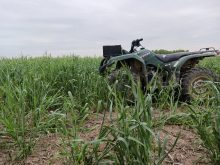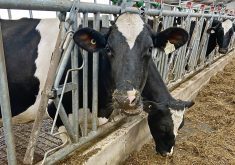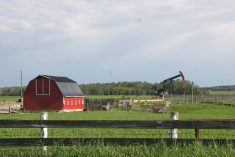The Perry family is well known in the Lethbridge area for its enthusiasm for the environment and sustainable farming practices.
Their farm at Chin, east of the city, is a landmark with its cluster of potato storage domes, a concept developed in the late 1970s to use less concrete and steel than other buildings with better wind and storm resistance.
Now the family blazing a new eco-energy trail, and recently held an open house to show friends and neighbours their plans for a biogas facility that will produce all the potato farm’s electricity needs from waste.
Read Also

Prairie winter snowfall forecast 2025-2026
How much snow should farmers in Alberta and elsewhere on the Canadian Prairies expect for the rest of December 2025 and into January-February 2026?
Chris Perry is heading Grow the Energy Circle Ltd. (Grow-tec), which will use manure, cull potatoes, food processor waste, and other biodegradable waste to continuously feed 630kW of electricity into the grid. The waste will go into an anaerobic digester to produce methane that will fuel a V-20 engine running a generator. It will take two digesters to produce 4,700 cubic metres of methane and maintain a continuous flow of 633KW of electricity into the grid. In the course of a year, the plant will offset more than 6,300 tonnes of CO2 equivalent.
The plant will produce enough power to meet the farm’s operations needs, such as running irrigation pumps and pivots and maintaining the controlled environments for potatoes. The Perrys will put the power into the grid and continue to buy electricity in order to prove they can deliver a constant voltage.
Perry is convinced he’s finally got a truly sustainable energy plan.
“This project will provide continuous clean, renewable energy from waste,” he says. “It’s better than wind and solar in its ability to produce consistent renewable power to the grid, not relying on wind or daylight. So it’s grid-friendly.”
Real-world experience
Highmark Renewables of Vegreville is working with Grow-tec to develop and run the facility, allowing the new company to benefit from Highmark’s “six years of painful learning” and experience. Real-world farm experience is vital, according to Mike Kotelko of Highmark.
“City engineers just tell you not to pick up rocks with the manure,” he says. “They don’t understand what’s possible and not possible in a farm waste situation.”
Grow-tec’s plan is to help the community by solving waste problems. The Perry farm is located within half a mile of a potato-processing plant and there are several other food processors within 20 miles. These plants will be able to dispose of their waste in a more environmentally friendly way. A local dairy, a hog farm and a feedlot will deliver manure to avoid odor problems and risk of contaminated runoff from land spreading.
The digesters process various feedstocks for about three days at 55 C, before tertiary digestion in a covered lagoon produces more methane, solid digestate, and nutrient-rich liquid. Five loads of manure will digest to about one load of solids – a compost-like material that can be used for bedding or as a soil amendment. Highmark has processed their product into pellets hard enough to run through an air seeder. The anaerobic conditions and high temperatures in the digesters kill weed seeds and pathogens in the feedstocks.
The Perrys plan to use some of the nutrient-rich liquid from primary and tertiary digestion to irrigate their crops. They are also planning to construct a wetland to purify the wastewater. The wetland will offer wildlife habitat, a park, and native plant species to provide a sanctuary for bees. Waste heat from electricity generation will be used for a greenhouse, perhaps an oil-from-algae facility. The Perrys are also considering processing the digestate into biochar as a soil amendment. Once it’s up and running, in fall of 2012, Growtec’s facility will employ one or two people full-time. Construction costs are expected to be around $3.5 million.
———
“It’sbetterthanwindandsolar initsabilitytoproduceconsistent renewablepowertothegrid,not relyingonwindordaylight,soit’s grid-friendly.”
CHRIS PERRY














